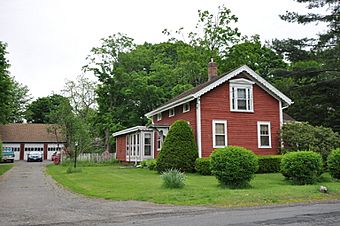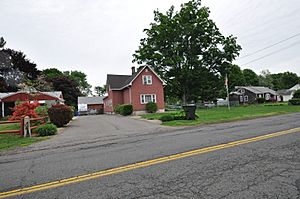Naubuc Avenue-Broad Street Historic District facts for kids
Quick facts for kids |
|
|
Naubuc Avenue-Broad Street Historic District
|
|
 |
|
| Location | Roughly along Broad St. and Naubuc Ave., East Hartford, Connecticut |
|---|---|
| Area | 32 acres (13 ha) |
| Built | 1941 |
| Architectural style | Colonial, Mid 19th Century Revival, Late Victorian |
| NRHP reference No. | 98001439 |
| Added to NRHP | December 4, 1998 |
The Naubuc Avenue-Broad Street Historic District is a special area in East Hartford, Connecticut. It used to be a farming village. This district stretches along Naubuc Avenue and Broad Street. It shows us what the area looked like from the 1700s to the early 1900s. It was added to the National Register of Historic Places in 1998. This means it is an important place worth protecting.
Contents
Exploring the Naubuc Avenue-Broad Street District
This historic district is shaped like an "L". It follows Naubuc Avenue north from the Glastonbury border. Then, it turns east along Broad Street until it reaches Main Street. Even though new homes are around these streets now, they still feel like they did in the 1700s and 1800s.
A Look at Early East Hartford History
For a long time, East Hartford was mostly farmland. People who owned the land lived across the Connecticut River in Hartford. People started living here permanently in the mid-1700s. More people moved in after the American Revolutionary War.
Naubuc Avenue was created around that time. It ran north from a ferry in Glastonbury. This road helped people get to Keeley Cove. A shipbuilding business even started there.
Farming and Factories in the District
In the 1830s, farming in the area changed. Farmers started growing tobacco to make cigars. This crop was very valuable. Tobacco farming was a big part of the area's economy for many years.
Around the same time, a small factory opened. It made silverware. This factory gave people jobs outside of farming.
Old Homes and Buildings in the District
The oldest house in the district was built around 1780. It belonged to John Kentfield, one of the first people to live here permanently. He built another house a few years later, further north on Naubuc Avenue.
There are other houses from the 1700s in the district. However, most of the buildings were built between the mid-1800s and early 1900s. You can see different styles of homes. Some are in the Greek Revival style. Others are fancy Queen Anne Victorians.
The only important building that wasn't a home was the Dudley Fox Silver Factory. It was built in 1855. It looked like a house, and now it has been changed into homes.




